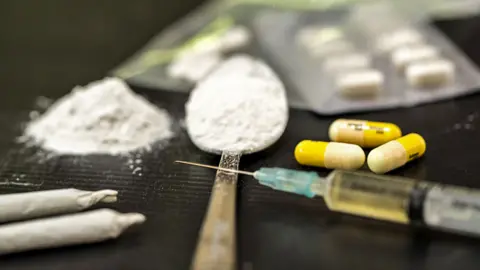Increase in suspected drugs deaths across Scotland
 Getty Images
Getty ImagesThe number of suspected drug deaths in Scotland increased towards the end of 2022, new figures show.
In the first nine months of last year, figures published by Public Health Scotland (PHS) showed a 21% reduction in the number of fatal overdoses.
However, numbers began to rise in later months, with 109 deaths in November alone.
Drug policy minister Angela Constance said the number of suspected drug deaths is "still far too high".
The PHS Rapid Action Drugs Alerts and Response (Radar) quarterly report showed 109 people had died from suspected drug deaths in November.
This is higher than the same month in both 2021 (89) and 2020 (93).
The report states that suspected drug deaths increased between October and November but figures for October were not included.
As a result of the rise in drug deaths in recent years, the Scottish government pledged to publish suspected drug death statistics on a quarterly basis, with the most recent release in December showing a fall of 15% between July and September when compared to the previous quarter.
Suspected drug deaths are based on Police Scotland management information and are not confirmed through toxicology.
 Getty Images
Getty ImagesCommenting on the report, drugs minister Ms Constance extended her "deepest sympathy to all those affected by the loss of a loved one through drugs".
She added: "Although the suspected drugs deaths figures showed a 21% decrease for the first nine months of last year, this latest report indicates a sharp increase in October and November.
"I am aware that this report uses management information provided by Police Scotland and is based on attending officers' observations and initial inquiries at the scene of death but, of course, the numbers we are seeing are still far too high.
"We remain focussed on our ongoing efforts to get more people into the form of treatment which works best for them."
Opioid alert
Radar also released an alert for emergency services and drugs workers about a group of synthetic opioids known as nitazenes, which have been discovered across the country and in prisons.
The alert claims most detections in Scotland were seen in fake oxycodone pills, sometimes stamped with an "M" or the number 30, while it has also been found in white paper form in prison seizures.
The drug has been detected in Lothian, Grampian and Greater Glasgow and Clyde, according to Radar.
A report from the Advisory Council on the Misuse of Drugs last year suggested at least 24 deaths came from nitazene substances in 2021, with the group suggesting the substances be considered Class A drugs.
The alert stated: "Due to their unexpected presence in the drug supply and high potency, nitazenes pose a substantial risk of overdose, hospitalisation and death.
"PHS strongly recommends people do not take non-prescribed oxycodone tablets."
